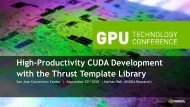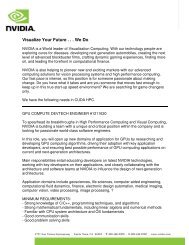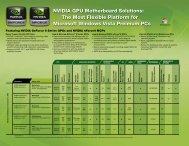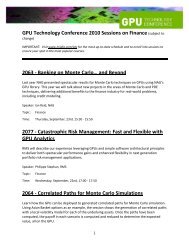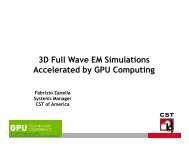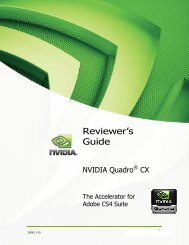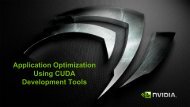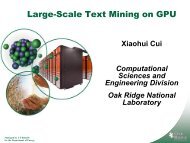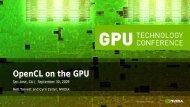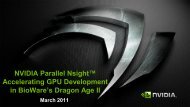GPU Computing with CUDA
GPU Computing with CUDA
GPU Computing with CUDA
Create successful ePaper yourself
Turn your PDF publications into a flip-book with our unique Google optimized e-Paper software.
The Future of <strong>GPU</strong> <strong>Computing</strong><br />
Bill Dally<br />
Chief Scientist & Sr. VP of Research, NVIDIA<br />
Bell Professor of Engineering, Stanford University<br />
November 18, 2009
The Future of <strong>Computing</strong><br />
Bill Dally<br />
Chief Scientist & Sr. VP of Research, NVIDIA<br />
Bell Professor of Engineering, Stanford University<br />
November 18, 2009
Outline<br />
Single-thread performance is no longer scaling<br />
Performance = Parallelism<br />
Efficiency = Locality<br />
Applications have lots of both<br />
Machines need lots of cores (parallelism) and an<br />
exposed storage hierarchy (locality)<br />
A programming system must abstract this<br />
The future is even more parallel
Single-threaded processor<br />
performance is no longer scaling
Moore’s Law<br />
Moore, Electronics 38(8) April 19, 1965<br />
In 1965 Gordon Moore predicted<br />
the number of transistors on an<br />
integrated circuit would double<br />
every year.<br />
Later revised to 18 months<br />
Also predicted L 3 power scaling<br />
for constant function<br />
No prediction of processor<br />
performance
More<br />
Transistors<br />
Architecture<br />
More<br />
Performance<br />
Applications<br />
More<br />
Value
The End of ILP Scaling<br />
1e+7<br />
1e+6<br />
1e+5<br />
1e+4<br />
1e+3<br />
1e+2<br />
1e+1<br />
1e+0<br />
Perf (ps/Inst)<br />
1980 1990 2000 2010 2020<br />
Dally et al., The Last Classical Computer, ISAT Study, 2001
Explicit Parallelism is Now Attractive<br />
1e+7<br />
1e+6<br />
1e+5<br />
1e+4<br />
1e+3<br />
1e+2<br />
1e+1<br />
1e+0<br />
1e-1<br />
1e-2<br />
1e-3<br />
1e-4<br />
30:1<br />
Perf (ps/Inst)<br />
Linear (ps/Inst)<br />
1,000:1<br />
1980 1990 2000 2010 2020<br />
Dally et al., The Last Classical Computer, ISAT Study, 2001<br />
30,000:1
Performance (vs. VAX-<br />
Single-Thread Processor<br />
Performance vs Calendar Year<br />
10000<br />
1000<br />
100<br />
10<br />
1<br />
25%/year<br />
52%/year<br />
20%/year<br />
1978 1980 1982 1984 1986 1988 1990 1992 1994 1996 1998 2000 2002 2004 2006<br />
Source: Hennessy & Patterson, CAAQA, 4th Edition
Single-threaded processor<br />
performance is no longer scaling<br />
Performance = Parallelism
Chips are power limited<br />
and most power is spent moving data
CMOS Chip is our Canvas<br />
20mm
4,000 64b FPUs fit on a chip<br />
64b FPU<br />
0.1mm 2<br />
50pJ/op<br />
1.5GHz<br />
20mm
Moving a word across die = 10FMAs<br />
Moving a word off chip = 20FMAs<br />
64b FPU<br />
0.1mm 2<br />
50pJ/op<br />
1.5GHz<br />
64b 1mm<br />
Channel<br />
25pJ/word<br />
64b Off-Chip<br />
Channel<br />
1nJ/word<br />
64b Floating Point<br />
10mm 250pJ, 4cycles<br />
20mm
Chips are power limited<br />
Most power is spent moving data<br />
Efficiency = Locality
Performance = Parallelism<br />
Efficiency = Locality
Scientific Applications<br />
Large data sets<br />
Lots of parallelism<br />
Increasingly irregular (AMR)<br />
Irregular and dynamic data structures<br />
Requires efficient gather/scatter<br />
Increasingly complex models<br />
Lots of locality<br />
Global solution sometimes bandwidth<br />
limited<br />
Less locality in these phases
Performance = Parallelism<br />
Efficiency = Locality<br />
Fortunately, most applications have lots of both.<br />
Amdahl’s law doesn’t apply to most future applications.
Exploiting parallelism and locality requires:<br />
Many efficient processors<br />
(To exploit parallelism)<br />
An exposed storage hierarchy<br />
(To exploit locality)<br />
A programming system that abstracts this
Tree-structured machines<br />
L1 L1 L1 L1<br />
P P P P<br />
L2<br />
Net<br />
L3<br />
Net
Optimize use of scarce bandwidth<br />
Provide rich, exposed storage hierarchy<br />
Explicitly manage data movement on this hierarchy<br />
Reduces demand, increases utilization<br />
Element<br />
Faces<br />
Compute<br />
Flux<br />
States<br />
Gathered<br />
Elements<br />
Face<br />
Geometry<br />
Compute<br />
Numerical<br />
Flux<br />
Read-Only Table Lookup Data<br />
(Master Element)<br />
Numerical<br />
Flux<br />
Gather<br />
Cell<br />
Cell<br />
Orientations<br />
Cell<br />
Geometry<br />
Compute<br />
Cell<br />
Interior<br />
Elements<br />
(Current)<br />
Advance<br />
Cell<br />
Elements<br />
(New)
Giga Thread<br />
DRAM I/F<br />
HOST I/F<br />
DRAM I/F<br />
Fermi is a throughput computer<br />
L2<br />
DRAM I/F<br />
DRAM I/F<br />
DRAM I/F<br />
DRAM I/F<br />
512 efficient cores<br />
Rich storage<br />
hierarchy<br />
Shared memory<br />
L1<br />
L2<br />
GDDR5 DRAM
Fermi
Avoid Denial Architecture<br />
Single thread processors are in denial about parallelism<br />
and locality<br />
They provide two illusions:<br />
Serial execution - Denies parallelism<br />
Tries to exploit parallelism <strong>with</strong> ILP - inefficient & limited<br />
scalability<br />
Flat memory - Denies locality<br />
Tries to provide illusion <strong>with</strong> caches – very inefficient<br />
when working set doesn’t fit in the cache<br />
These illusions inhibit performance and efficiency
<strong>CUDA</strong> Abstracts the <strong>GPU</strong> Architecture<br />
Programmer sees many cores and<br />
exposed storage hierarchy, but is isolated<br />
from details.
<strong>CUDA</strong> as a Stream Language<br />
Launch a cooperative thread array<br />
foo(x, y, z) ;<br />
Explicit control of the memory hierarchy<br />
__shared__ float a[SIZE] ;<br />
Also enables communication between threads of a<br />
CTA<br />
Allows access to arbitrary data <strong>with</strong>in a kernel
146X<br />
Interactive<br />
visualization of<br />
volumetric white<br />
matter connectivity<br />
149X<br />
Financial simulation<br />
of LIBOR model <strong>with</strong><br />
swaptions<br />
36X<br />
Ionic placement for<br />
molecular dynamics<br />
simulation on <strong>GPU</strong><br />
47X<br />
GLAME@lab: an Mscript<br />
API for <strong>GPU</strong><br />
linear algebra<br />
Examples<br />
19X<br />
Transcoding HD video<br />
stream to H.264<br />
20X<br />
Ultrasound medical<br />
imaging for cancer<br />
diagnostics<br />
17X<br />
Fluid mechanics in<br />
Matlab using .mex file<br />
<strong>CUDA</strong> function<br />
24X<br />
Highly optimized<br />
object oriented<br />
molecular dynamics<br />
100X<br />
Astrophysics N-body<br />
simulation<br />
30X<br />
Cmatch exact string<br />
matching to find<br />
similar proteins and<br />
gene sequences
Current <strong>CUDA</strong> Ecosystem<br />
Over 200 Universities Teaching<br />
<strong>CUDA</strong><br />
Applications Libraries<br />
Oil &<br />
Gas<br />
UIUC<br />
MIT<br />
Harvard<br />
Berkeley<br />
Cambridge<br />
Oxford<br />
…<br />
Finance<br />
Medical Biophysics<br />
Numerics<br />
CFD<br />
Imaging<br />
DSP EDA<br />
IIT Delhi<br />
Tsinghua<br />
Dortmundt<br />
ETH Zurich<br />
Moscow<br />
NTU<br />
…<br />
FFT<br />
BLAS<br />
LAPACK<br />
Image<br />
processing<br />
Video processing<br />
Signal<br />
processing<br />
Vision<br />
Languages<br />
C, C++<br />
DirectX<br />
Fortran<br />
OpenCL<br />
Python<br />
Compilers<br />
PGI Fortran<br />
CAPs HMPP<br />
M<strong>CUDA</strong><br />
MPI<br />
NOAA Fortran2C<br />
OpenMP<br />
Consultants OEMs<br />
ANEO<br />
<strong>GPU</strong> Tech
Ease of Programming<br />
Source: Nicolas Pinto, MIT
The future is even more parallel
CPU scaling ends, <strong>GPU</strong> continues<br />
Source: Hennessy & Patterson, CAAQA, 4th Edition<br />
2017
DARPA Study Indentifies four<br />
challenges for ExaScale <strong>Computing</strong><br />
Report published September 28, 2008:<br />
Four Major Challenges<br />
Energy and Power challenge<br />
Memory and Storage challenge<br />
Concurrency and Locality challenge<br />
Resiliency challenge<br />
Available at<br />
www.darpa.mil/ipto/personnel/docs/ExaScale_Study_Initial.pdf<br />
Number one issue is power<br />
Extrapolations of current architectures and<br />
technology indicate over 100MW for an Exaflop!<br />
Power also constrains what we can put on a chip
Energy and Power Challenge<br />
Heterogeneous architecture<br />
A few latency-optimized processors<br />
Many (100s-1,000s) throughput-optimized processors<br />
Which are optimized for ops/J<br />
Efficient processor architecture<br />
Simple control – in-order multi-threaded<br />
SIMT execution to amortize overhead<br />
Agile memory system to capture locality<br />
Keeps data and instruction access local<br />
Optimized circuit design<br />
Minimize energy/op<br />
Minimize cost of data movement<br />
* This section is a projection based on Moore’s law and does not represent a committed roadmap
An NVIDIA ExaScale Machine in 2017<br />
2017 <strong>GPU</strong> Node – 300W (<strong>GPU</strong> + memory + supply)<br />
2,400 throughput cores (7,200 FPUs), 16 CPUs – single chip<br />
40TFLOPS (SP) 13TFLOPS (DP)<br />
Deep, explicit on-chip storage hierarchy<br />
Fast communication and synchronization<br />
Node Memory<br />
128GB DRAM, 2TB/s bandwidth<br />
512GB Phase-change/Flash for checkpoint and scratch<br />
Cabinet – ~100kW<br />
384 Nodes – 15.7PFLOPS (SP), 50TB DRAM<br />
Dragonfly network – 1TB/s per node bandwidth<br />
System – ~10MW<br />
RAS<br />
128 Cabinets – 2 EFLOPS (SP), 6.4 PB DRAM<br />
Distributed EB disk array for file system<br />
Dragonfly network <strong>with</strong> active optical links<br />
ECC on all memory and links<br />
Option to pair cores for self-checking (or use application-level checking)<br />
Fast local checkpoint<br />
* This section is a projection based on Moore’s law and does not represent a committed roadmap
Conclusion
Performance = Parallelism<br />
Efficiency = Locality<br />
Applications have lots of both.<br />
<strong>GPU</strong>s have lots of cores (parallelism) and an exposed storage<br />
hierarchy (locality)



